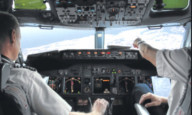
Euro MPs are set to rubber stamp new rules that will make flying more dangerous, according to industry experts.
If the new regulations are passed, holidaymakers jetting off to the sun next summer could find their flight helmed by a pilot who has already been awake for nearly 24 hours.
That’s despite pilot fatigue accounting for one in five fatal air crashes and nearly half of British pilots reporting they’ve fallen asleep at the flight deck involuntarily.
An EU directive on pilots flying time comes before a committee of MEPs from across Europe for approval tomorrow. But the new standards are actually lower than those currently in place in the UK.
The EU rules will mean pilots will have to fly for longer, face more early starts in a row and be asked to take on more demanding night flights.
Richard Toomer, of the British Airline Pilots Association, blasted: “These proposals are a massive threat to flight safety.”
He warned that the new rules will put “downward pressure” on agreements already drawn up with airlines about the amount of time pilots can fly and when.
He added: “It’s universally agreed that Britain has some of the best rules on fatigue.
“We want to see everyone level up to the UK instead of sacrificing standards.”
In an unusual move, Westminster’s Transport Select Committe reported it was “worried” about the proposals and asked the Government to reject them.
Chairman Louise Ellmann said: “Flight time limitations remain a serious concern with 43% of UK pilots reporting falling asleep involuntarily while on the flight deck.
“It is vital that high aviation safety standards are maintained.
“That is why the new flight time regulation must be closely scrutinised and the Committee’s concerns taken forward.”
Currently pilots are limited to 10 hours flying time at night. That would rise to 11 hours despite scientists warning it’s too long.
The proposals would also scrap the current limit of three early starts in a row.
In the face of previous criticism the EU dropped plans to increase overall flying time but critics claim the new directive could see pilots who have been awake for a total of 22 hours expected to land planes.
However the European Commission claim the circumstances in which that could happen are extremely remote.
Behind the scenes, they are accusing British pilots of using safety as a political football.
A spokeswoman for the European Commission said: “Safety is the only objective of the Commission proposal to revise the current EU rules in relation to flight time limitations.”

Enjoy the convenience of having The Sunday Post delivered as a digital ePaper straight to your smartphone, tablet or computer.
Subscribe for only £5.49 a month and enjoy all the benefits of the printed paper as a digital replica.
Subscribe